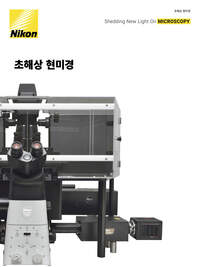- ko Change Region
- Global Site
N-SIM S
Super-Resolution Microscope System
단종 제품
The Principle of Structured Illumination Microscopy
Analytical processing of recorded moiré patterns produced by overlay of a known high spatial frequency pattern, mathematically restores the sub-resolution structure of a specimen.
Utilization of high spatial frequency laser interference to illuminate sub-resolution structure within a specimen produces moiré fringes, which are captured. These moiré fringes include modulated information of the sub-resolution structure of the specimen.
Through image processing, the unknown specimen information can be recovered to achieve resolution beyond the limit of conventional light microscopes.
Create super-resolution images by processing multiple moiré pattern images
An image of moiré patterns captured in this process includes information of the minute structures within a specimen. Multiple phases and orientations of structured illumination are captured, and the displaced "super resolution" information is extracted from moiré fringe information. This information is combined mathematically in "Fourier" or aperture space and then transformed back into image space, creating an image at double the conventional resolution limit.
Utilizing high-frequency striped illumination to double the resolution
The capture of high resolution, high spatial frequency information is limited by the Numerical Aperture (NA) of the objectives, and spatial frequencies of structure beyond the optical system aperture are excluded (Fig. A). Illuminating the specimen with high frequency structured illumination, which is multiplied by the unknown structure in the specimen beyond the classical resolution limit, brings the displaced "super resolution" information within the optical system aperture (Fig. B).
When this "super-resolution" information is then mathematically combined with the standard information captured by the objective lens, it results in resolutions equivalent to those captured with objective lenses with approximately double the NA (Fig. C).




